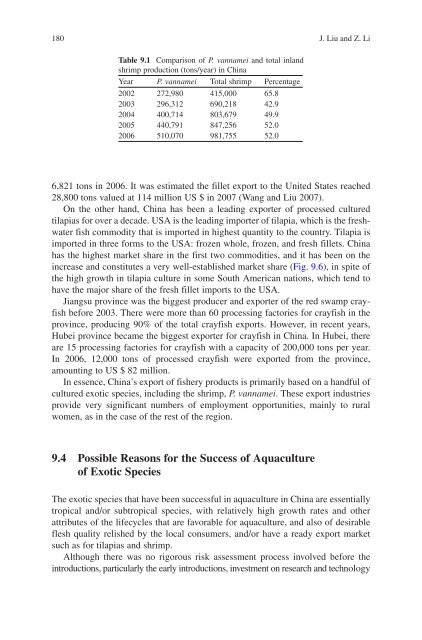Success Stories In Asian Aquaculture - Library - Network of ...
Success Stories In Asian Aquaculture - Library - Network of ...
Success Stories In Asian Aquaculture - Library - Network of ...
- No tags were found...
Create successful ePaper yourself
Turn your PDF publications into a flip-book with our unique Google optimized e-Paper software.
180 J. Liu and Z. LiTable 9.1 Comparison <strong>of</strong> P. vannamei and total inlandshrimp production (tons/year) in ChinaYear P. vannamei Total shrimp Percentage2002 272,980 415,000 65.82003 296,312 690,218 42.92004 400,714 803,679 49.92005 440,791 847,256 52.02006 510,070 981,755 52.06,821 tons in 2006. It was estimated the fillet export to the United States reached28,800 tons valued at 114 million US $ in 2007 (Wang and Liu 2007) .On the other hand, China has been a leading exporter <strong>of</strong> processed culturedtilapias for over a decade. USA is the leading importer <strong>of</strong> tilapia, which is the freshwaterfish commodity that is imported in highest quantity to the country. Tilapia isimported in three forms to the USA: frozen whole, frozen, and fresh fillets. Chinahas the highest market share in the first two commodities, and it has been on theincrease and constitutes a very well-established market share (Fig. 9.6 ), in spite <strong>of</strong>the high growth in tilapia culture in some South American nations, which tend tohave the major share <strong>of</strong> the fresh fillet imports to the USA.Jiangsu province was the biggest producer and exporter <strong>of</strong> the red swamp crayfishbefore 2003. There were more than 60 processing factories for crayfish in theprovince, producing 90% <strong>of</strong> the total crayfish exports. However, in recent years,Hubei province became the biggest exporter for crayfish in China. <strong>In</strong> Hubei, thereare 15 processing factories for crayfish with a capacity <strong>of</strong> 200,000 tons per year.<strong>In</strong> 2006, 12,000 tons <strong>of</strong> processed crayfish were exported from the province,amounting to US $ 82 million.<strong>In</strong> essence, China’s export <strong>of</strong> fishery products is primarily based on a handful <strong>of</strong>cultured exotic species, including the shrimp, P. vannamei . These export industriesprovide very significant numbers <strong>of</strong> employment opportunities, mainly to ruralwomen, as in the case <strong>of</strong> the rest <strong>of</strong> the region.9.4 Possible Reasons for the <strong>Success</strong> <strong>of</strong> <strong>Aquaculture</strong><strong>of</strong> Exotic SpeciesThe exotic species that have been successful in aquaculture in China are essentiallytropical and/or subtropical species, with relatively high growth rates and otherattributes <strong>of</strong> the lifecycles that are favorable for aquaculture, and also <strong>of</strong> desirableflesh quality relished by the local consumers, and/or have a ready export marketsuch as for tilapias and shrimp.Although there was no rigorous risk assessment process involved before theintroductions, particularly the early introductions, investment on research and technology
















